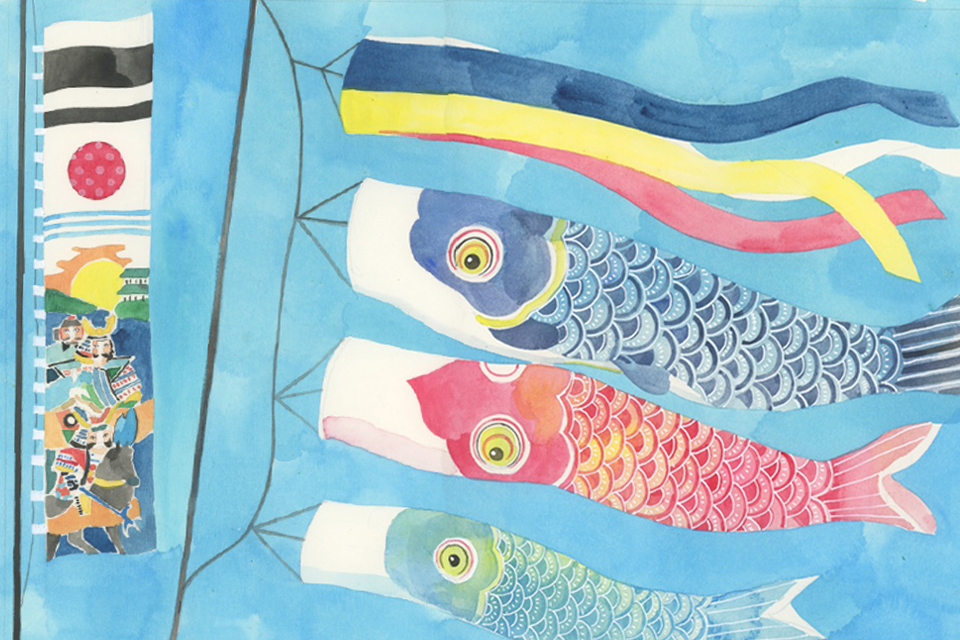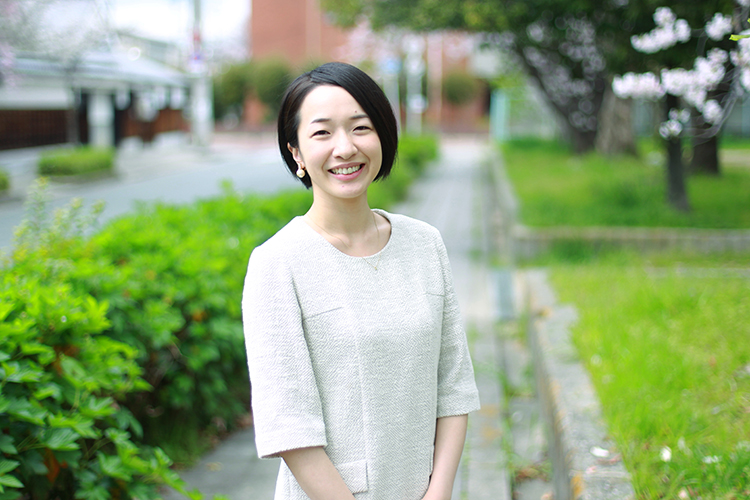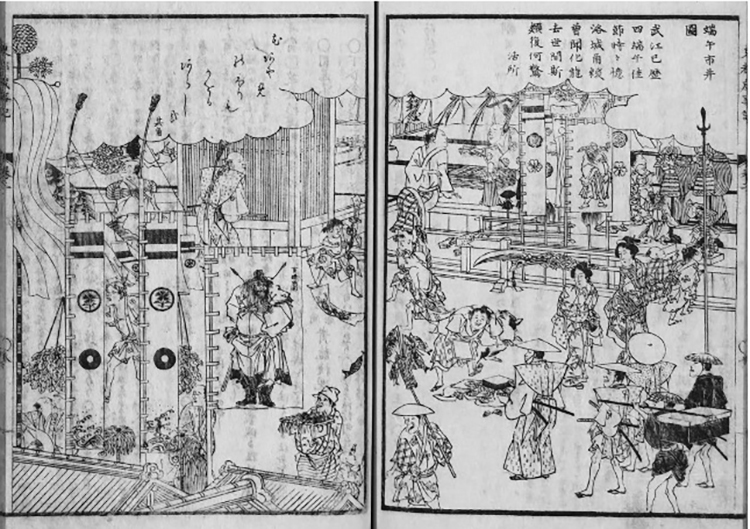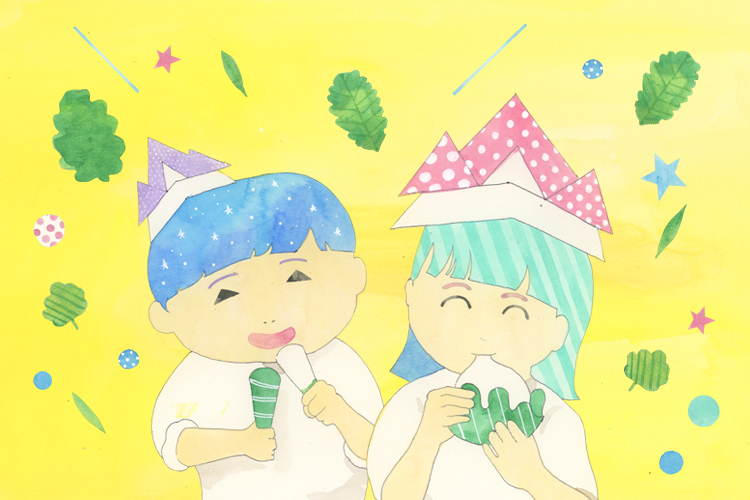Kashiwamochi & Carp Streamers: Children's Day in Japan
Apr 28,2022
Kashiwamochi & Carp Streamers: Children's Day in Japan
Apr 28,2022


What does the mention of Children’s Day bring to mind? For Japanese readers, it may evoke the familiar children’s song that begins, “Carp streamers higher than the rooftops.” Children’s Day falls on the day of the Tango Festival, one of the five traditional seasonal festivals. Here food culture expert Kiyoshi Aya tells us more about the Tango Festival.
Children’s Day falls on May 5, the day of the Tango Festival, one of the five traditional seasonal festivals. The five seasonal festivals are the seventh of the first month, the third of the third month, the fifth of the fifth month, the seventh of the seventh month, and the ninth of the ninth month. They originate in ancient China, where dates repeating the same odd number were considered inauspicious. Various rites were therefore held on each to expel evil spirits. Today, these traditional festivals survive in the form of such celebrations as Tanabata and the Doll Festival.
So how did the Tango Festival end up becoming Children’s Day?

Food culture expert Kiyoshi Aya
“In ancient China, the sweet flag was used to exorcise evil spirits on the fifth day of the fifth month. The plant’s strong scent was believed to have apotropaic properties. For example, Festivals and Seasonal Customs of the Jing-Chu Region, an account of customs and annual rituals in the Six Dynasties period, describes how people would drink sweet-flag wine—made by soaking sweet flag in rice wine—to ward off evil and protect themselves against disease. Because of this old Chinese custom, the Tango Festival is also called the Sweet Flag Festival.”
Like the five seasonal festivals themselves, this observance reached Japan during the Nara (710-784) and Heian (794-1185) periods, according to Aya. It became a part of aristocratic life and gradually took root as a court ritual.
Events such as mounted archery and horseracing had been held on this day since olden times. Later, in the Kamakura (1185-1333) and Muromachi (1336-1573) periods, a uniquely Japanese set of customs emerged.
“With the advent of the age of the samurai, the Tango Festival came to be thought of as a day to celebrate boyhood and honor the martial arts. You see, the Japanese word for ‘sweet flag’ is shōbu, and this was reinterpreted to mean ‘contest’ or ‘warlike,’ with which it sounds the same. That’s why the Tango Festival evolved from a day of exorcism into a celebration of boys’ growth.”
The present custom of displaying a helmet or warrior doll on Children’s Day also originated in this era.
“In olden times, a wreath of sweet-flag leaves was worn on the head to repel evil spirits. This gradually evolved into a helmet. In the Edo period (1603-1867), warrior dolls came to be displayed as they are today. Contemporary sources indicate that they were displayed inside the home facing outward so as to be visible to passersby.”
At this point, some readers may be wondering why the koi nobori or “carp streamers” that are a common sight on Children’s Day haven’t been mentioned yet. The fact is, Aya notes, that carp streamers didn’t appear until the latter half of the Edo period.
“Nobori means a banner displayed in front of a store and emblazoned with the name of what it sells. Initially, banners like these were displayed on the Tango Festival. They bore portraits of warriors and were displayed outdoors. This practice survives today in various parts of Kyushu. Some readers may have encountered it.

Illustration of the Tango Festival from Tōto saijiki (1838).
A man carrying a carp streamer on his shoulder is shown at the lower center. Source: National Diet Library Digital Collections.
“Tōto saijiki, an 1838 account of the customs of Edo (present Tokyo), describes how banners were placed outside on the fifth day of the fifth month, and helmeted dolls were put on display. It also notes that displaying paper carps alongside the banners was a recent custom peculiar to Edo.
“In other words, carp streamers first appeared in the city of Edo in the later Edo period. The image of a carp valiantly ascending a waterfall was a popular design among Edoites, because it was considered auspicious.”
The first carp streamers sold in Edo were made of paper and small enough to carry in one’s hand.
“It was an era of peace and prosperity, and carp streamers were a hot commodity in the thriving cultural center of Edo. They became increasingly striking, eventually evolving into the huge windsocks of fabric familiar today. But it wasn’t until after the war that carp streamers spread throughout the country and ordinary homes began flying them. So in fact it’s a recent custom.”

Children’s Day also brings to mind snacks like chimaki (rice wrapped in bamboo or other leaves) and kashiwa mochi (rice cakes filled with sweet bean paste and wrapped in oak leaves).
“Chimaki originally come from China. The word means literally ‘cogon grass (chi) wrap (maki).’ Chimaki came to be eaten on the fifth day of the fifth month, it’s said, due to their association with the ancient Chinese statesman Qu Yuan.”
In Japan, there aren’t just rice cakes wrapped in cogon grass. Rice cakes wrapped in various types of leaves, including bamboo leaves, reeds, and Japanese ginger leaves, can be found in different parts of the country.
“Rice-cake snacks continue to be enjoyed today as Tango Festival treats in different regions. Niigata, for example, has sasa dango. Yamagata has sasa maki. Kagoshima has aku maki.”

Sasa maki from Yamagata (right) and aku maki from Kagoshima (left)
Kashiwa mochi, one of the best-known Tango festival foods, came to be eaten throughout the country in the latter half of the Edo period, according to Aya. The catalyst was a confectioner in Edo that started selling kashiwa mochi, which already existed as a snack, specifically for the day of the festival.
“The custom of eating kashiwa mochi on the Tango Festival originated in Edo. People in the western part of Japan mainly ate chimaki. Kashiwa mochi don’t yet appear in sources on the customs of Osaka in the late Edo period. One source records that in Kanazawa, kashiwa mochi only started being eaten in the late 1920s or 1930s on the model of what people in Tokyo did.”

Man overturning a tray of kashiwa mochi and a chimaki vendor.
Illustrations from Tōto saijiki (1838). Source: National Diet Library Digital Collections.
Kashiwa mochi today come with several types of sweet bean paste filling, including smooth, lumpy, or mixed with miso. What kind of kashiwa mochi did people eat in the Edo period?
“Actually, it’s believed that kashiwa mochi were originally made with salted bean paste. The common people back in those days didn’t eat sweet confections, and bean paste was typically salty. Kashiwa mochi containing miso bean paste or sweet bean paste probably started being eaten in the second half of the Edo period as sugar became widely available.”
The Tango Festival is a celebration of children’s growth, and its history mirrors human aspirations. It reflects people’s desire to be free of illness, to see their children grow up in good health, to live each day in joy and prosperity. As you mark Children’s Day this year, you might want to give a thought to such eternal human hopes.

Food culture expert
Food culture expert
Secretary, Research and Study Committee, Washoku Association of Japan
Kiyoshi Aya is an expert in food culture history, traditional festive foods, and local cuisine. Her recent publications include two coauthored books, Washoku Notebook and Hometown Foods (Washoku Culture Booklet 8) (both published by Shibunkaku), as well as the 3rd edition of Food Atlas (published by Teikoku Shoin).